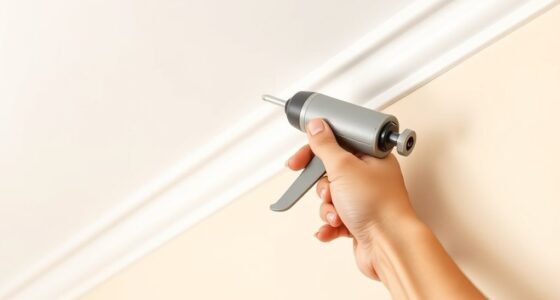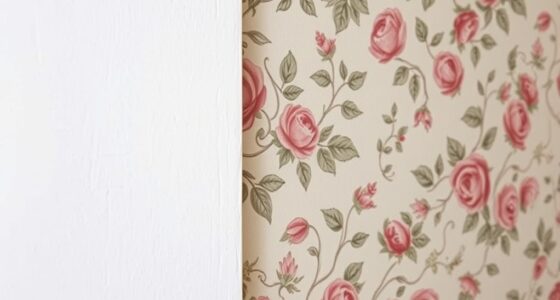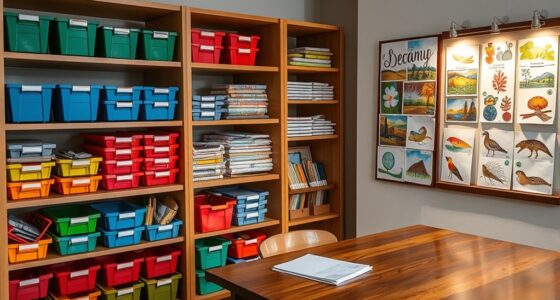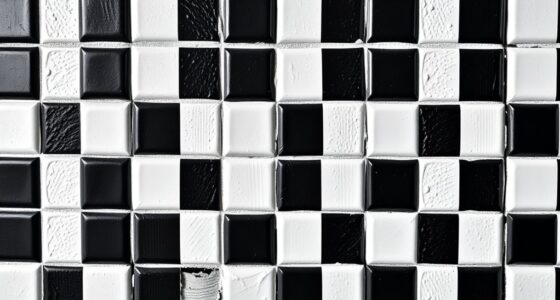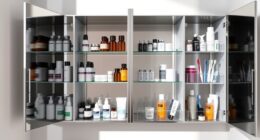To calculate paint quantity accurately, measure each surface’s length and height to determine square footage, then total these areas. Check the coverage rate on the paint can, divide the total area by this figure, and add about 10% for extra. Consider surface texture and color mixing, which can affect coverage. Using proper techniques helps avoid waste. Keep this in mind, and you’ll find it easier to estimate your paint needs efficiently. To learn more, continue exploring these steps in detail.
Key Takeaways
- Measure the total surface area by multiplying length and height of each wall or surface.
- Check the paint can label for coverage rate (sq ft per gallon) and divide total area by this value.
- Add approximately 10% extra to account for surface texture, coating thickness, and touch-ups.
- Use appropriate brushes and consistent techniques to minimize paint waste and ensure even coverage.
- Mix sufficient paint batches for uniform color and plan for additional paint when combining colors or shades.
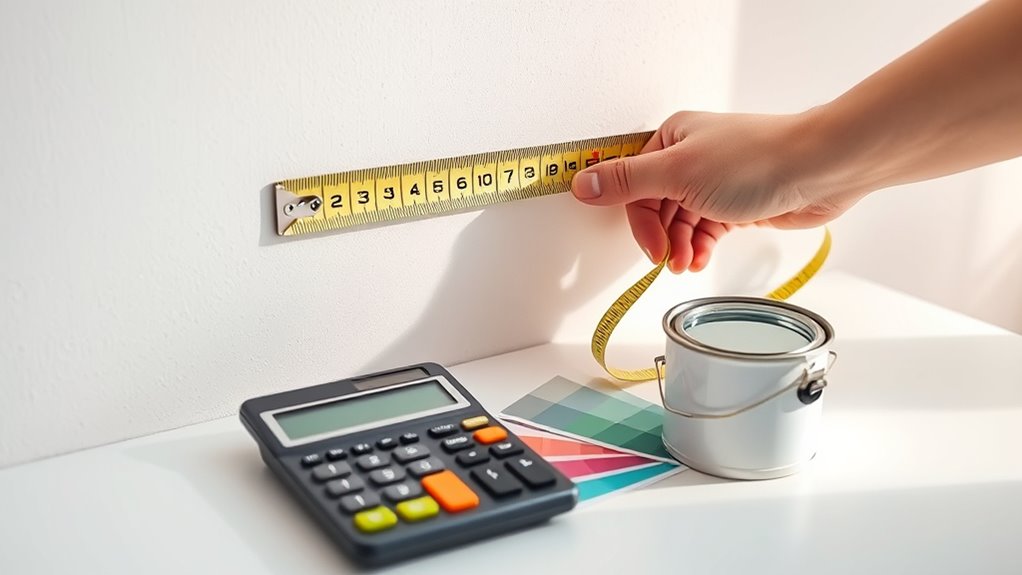
Knowing how much paint you’ll need is vital before starting any painting project, as it helps you avoid both shortages and excess. To determine the right amount, you need to consider the surface area you plan to cover and the type of paint you’re using. Start by measuring the length and height of each wall or surface, then multiply these dimensions to get the square footage. If you’re working on multiple walls, add up all the measurements to get a total area. Keep in mind that different surfaces absorb paint differently, so you may need to adjust your calculations accordingly.
Accurately measuring surface area ensures you buy the right amount of paint for your project.
Once you have the total surface area, consult the paint can or product label to find the coverage rate, usually expressed in square feet per gallon or liter. Divide your total area by this coverage rate to estimate how many gallons or liters you’ll need. It’s wise to add a little extra—generally 10%—to account for surface texture, uneven coats, or future touch-ups. This buffer ensures you won’t run out midway through your project, which can lead to mismatched patches and wasted time.
When it comes to achieving the perfect finish, brush techniques play a significant role. Proper brush strokes can influence how much paint you use and how smoothly it spreads. Using the right brush for your project and applying paint in consistent, even strokes helps minimize drips and uneven coverage, reducing the need for multiple coats. This, in turn, affects your overall paint quantity calculation, as efficient brush techniques can decrease the amount of paint needed.
Another vital factor is paint color mixing. If you plan to mix colors or create custom shades, remember that mixing can alter the overall amount of paint required. Mixing small amounts of different colors often results in a need for more paint to achieve the desired hue uniformly, especially when working with multiple batches. To avoid miscalculations, mix enough paint in one batch to cover the entire surface or plan for extra to accommodate blending. Proper paint color mixing not only guarantees consistency but also prevents underestimating your total paint needs. Additionally, understanding paint coverage can help you make more accurate estimates and reduce waste.
Frequently Asked Questions
How Does Surface Texture Affect Paint Coverage?
Surface roughness considerably impacts paint coverage because rougher textures require more paint to fill in the gaps and create a smooth finish. When you work on a surface with high roughness, paint adhesion can be affected, leading to uneven application and increased consumption. To get the best coverage, you should consider sanding rough surfaces and choosing the right type of paint, ensuring it adheres well and covers thoroughly.
Can I Use Leftover Paint for Touch-Ups Later?
Yes, you can use leftover paint for touch-ups later. Just guarantee proper paint mixing to restore consistency, stir thoroughly to blend any settling, and check color matching before applying. Store leftover paint in airtight containers, label them clearly, and keep them in a cool, dry place. By maintaining good storage habits, you’ll make your touch-up jobs seamless, saving time and money while keeping your walls looking fresh and uniform.
What Safety Precautions Should I Take During Painting?
When painting, you should always wear safety gear like gloves, goggles, and a mask to protect yourself from fumes and splatters. Make sure to work in a well-ventilated area, especially during paint mixing, to avoid inhaling harmful vapors. Keep your workspace tidy, and store paint and chemicals safely out of children’s reach. These precautions help guarantee your safety and a successful, hazard-free painting project.
How Do Primer Coats Influence Overall Paint Needs?
Primer coats critically influence your overall paint needs because they improve adhesion and surface coverage. A good primer reduces the amount of paint required for the final coat by sealing pores and imperfections. This primer influence means you might use less paint overall, saving you money and time. Remember, applying a proper primer ensures a smoother finish and can decrease your total paint consumption, making your project more efficient.
Are There Eco-Friendly Paint Options Available?
Yes, eco-friendly paints are everywhere now, and you’ll love how they transform your space without harming the planet! You can choose from a variety of low VOC options that emit almost no fumes, making your home healthier and safer. These eco-friendly paints come in vibrant colors and durable finishes, proving that caring for the environment doesn’t mean sacrificing style or quality. Go green and paint your next project with confidence!
Conclusion
Now that you know how to calculate paint accurately, you’re practically a painting wizard! With these simple steps, you’ll never run out of paint mid-job or waste a single drop. Remember, precise measurements save money and time—think of it as turning a mountain of paint into a molehill. Mastering this skill transforms a formidable task into a smooth, enjoyable project. So go ahead, conquer your painting goals with confidence and make your space truly shine!


